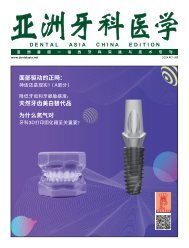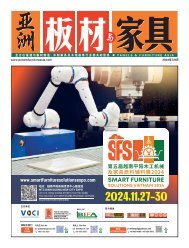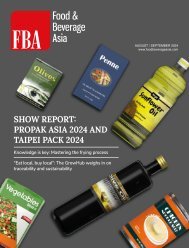Dental Asia March/April 2019
For more than two decades, Dental Asia is the premium journal in linking dental innovators and manufacturers to its rightful audience. We devote ourselves in showcasing the latest dental technology and share evidence-based clinical philosophies to serve as an educational platform to dental professionals. Our combined portfolio of print and digital media also allows us to reach a wider market and secure our position as the leading dental media in the Asia Pacific region while facilitating global interactions among our readers.
For more than two decades, Dental Asia is the premium journal in linking dental innovators
and manufacturers to its rightful audience. We devote ourselves in showcasing the latest dental technology and share evidence-based clinical philosophies to serve as an educational platform to dental professionals. Our combined portfolio of print and digital media also allows us to reach a wider market and secure our position as the leading dental media in the Asia Pacific region while facilitating global interactions among our readers.
Create successful ePaper yourself
Turn your PDF publications into a flip-book with our unique Google optimized e-Paper software.
Behind the Scenes<br />
angles due to the labial placement of the<br />
teeth in the motivational mock-up. Failure<br />
to only show the two-dimensional facial<br />
photograph will result in the patient losing<br />
confidence in the treatment and feeling<br />
their teeth “are sticking out”. This is still<br />
an essential part of the treatment as it is<br />
the only stage in a reductive case where<br />
you are able to show the patient a live<br />
cosmetic smile trial without performing an<br />
irreversible procedure (Fig. 15).<br />
Fig. 15<br />
Ideal mock-up<br />
Following the sign-off of the additive<br />
mock-up by the patient an ideal mockup<br />
was created. This was done in the<br />
laboratory using 3Shape <strong>Dental</strong> Design.<br />
The existing additive mock-up was<br />
repositioned palatally in the correct<br />
position of the final restorations. The<br />
new final tooth position model was<br />
3D printed and a preparation guide<br />
was made to ensure exact reduction<br />
for minimal thickness lithium disilicate<br />
veneers. This model is also used to<br />
make the key for the temporary veneers<br />
(Figs. 16-18).<br />
Fig. 18<br />
Veneer removal, tooth preparation<br />
and temporisation<br />
Following anaesthetic administration,<br />
the existing veneers were removed using<br />
a diamond bur and handpiece. After<br />
assessment, the existing porcelain and<br />
resin was removed and the ideal mock-up<br />
putty key was checked for a passive seat<br />
and filled with Expertemp (Ultradent). The<br />
key was then removed following curing<br />
and the final position of the veneers<br />
assessed. Next, 0.5mm was removed<br />
in the A, B and C planes through the<br />
Expertemp to ensure minimal thickness<br />
of the glass ceramic. Particular attention<br />
must be paid to the C plane to ensure<br />
adequate reduction in the incisal area<br />
preventing flaring of the final restorations.<br />
The remaining Expertemp was then<br />
removed (Fig. 19).<br />
health which was essential for this patient.<br />
Following accurate assessment of the<br />
gingivectomy, laser troughing was<br />
performed to create a defined margin<br />
prior to the 3Shape TRIOS 3 scan.<br />
The preparations were then scanned<br />
and uploaded to Race <strong>Dental</strong> using<br />
3Shape Communicate for same day<br />
merging with the pre-preparation<br />
(ideal mock-up) in the laboratory. The<br />
teeth were then temporised using the<br />
ideal mock-up putty key and Expertemp<br />
(Fig. 20).<br />
Fig. 20<br />
CAD and Milling<br />
The ideal mock-up and digital<br />
3Shape TRIOS 3 scan were uploaded<br />
into 3Shape <strong>Dental</strong> Design to create the<br />
individual CAD files ahead of milling.<br />
Using this software integration enables<br />
the predictable replication of the design<br />
as shown to the patient and the clinician<br />
throughout the planning process. This<br />
repeatability and predictability showcases<br />
the power of a fully digital workflow<br />
(Figs. 21-22).<br />
Fig. 16<br />
Fig. 17<br />
Fig. 19<br />
Gingivectomy was required on the central<br />
and lateral incisors. This was performed at<br />
the time of preparation using the Gemini<br />
dual wavelength diode laser (Ultradent).<br />
The height of the gingivectomy was<br />
defined by the gingival position on the<br />
ideal mock-up created in the lab, using<br />
3Shape <strong>Dental</strong> Design. The cutting and<br />
cauterising characteristics of the super<br />
pulsed diode laser enables precise and<br />
predictable gingival removal, preventing<br />
the need for second stage surgery.<br />
Additionally, the diode laser will disinfect<br />
the gingival sulcus and improve tissue<br />
Fig. 21<br />
Fig. 22<br />
64<br />
DENTAL ASIA MARCH / APRIL <strong>2019</strong>


















